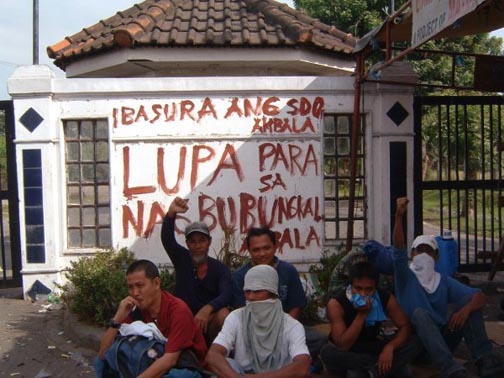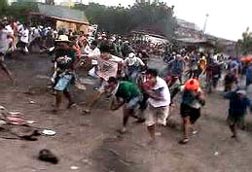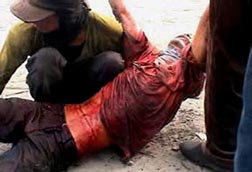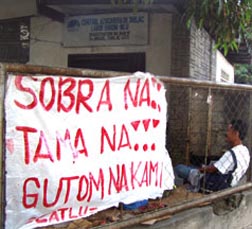
December 2004
Massacre of Sugar Plantation Workers
in the Philippines

Protesters at Hacienda
Luisita in front of banner of the Ambala peasant organization.
Photo: Manila Indymedia
Mobilize the Working Class to
Avenge the Martyrs and Win Strike!
In the
afternoon of
November 16, Filipino police and army units carried out a brutal
massacre of
striking sugar plantation workers at Hacienda Luisita, located in
Tarlac
province in central Luzon, north of Manila. After a stand-off with the
strikers
the day before, some 1,000 cops and troops were sent to the hacienda
headquarters,
accompanied by two armored personnel carriers, fire trucks and water
cannons.
After launching a volley of tear gas grenades, Army riflemen fired
point-blank
into the picketers’ front lines using live ammunition. A 60-calibre
machine gun
was also used. Truncheon wielding police chased migrant workers into
their
barracks and later combed the ten barangays (villages) where
hacienda
workers live. “Soldiers were allegedly ‘zoning’ Barangay Motrico,
dragging men
out of their homes and lining them up to be arrested,” the Philippines
Daily
Inquirer (17 November) reported. Dead bodies were found scattered
all
around the main gate and the barracks. A total of 14 people were
reported
killed, including two children suffocated by the tear gas, and some 200
injured,
over 30 with gunshot wounds. A total of 133 strikers and their
supporters were arrested.
The
Hacienda Luisita
massacre is the worst slaughter of Filipino workers in recent years. It
underlines the fraud of bourgeois “democracy,” which rains death on the
exploited and oppressed fighting for their rights. It is all the more
significant because the police and army attack was ordered directly
from the
central government, by Labor Secretary Patricia Sto. Tomas, and was
carried out
on behalf of the Cojuangco family, prominent landowners including
former
president Corazon Cojuangco Aquino. The current president, Gloria
Macapagal
Arroyo, responded to the mass killing with empty platitudes and
“prayers.”
Spokesmen for the Hacienda justified the bloodbath as a “legitimate
exercise of
state power,” saying the work stoppage was “illegal and left-inspired.”
Plantation workers had gone on strike November 6 demanding the
reinstatement of
some 327 unionists, including nine union leaders, fired ten days
earlier by the
management of the hacienda and the sugar mill (Central Azucarera de
Tarlac,
CAT). As thousands of strikers and their supporters occupied the
facilities,
the Department of Labor and Employment (DOLE) declared it was assuming
jurisdiction for the dispute and ordered in three military battalions
to take
down the picket lines and disperse the strikers.
Hacienda
Luisita tries to
sell itself as luxurious modern resort, complete with covered tennis
courts,
swimming pool with Jacuzzi, a championship golf course, business park
and
“simple yet elegant” hotel, “your hacienda home.” Yet this “fusion of
agriculture and industry” is based on the superexploitation of workers
who live
a miserable existence enforced by an age-old system of “landlordism and
state
terrorism,” as the magazine Bulatlat (21 November) put it. The
Philippine Army’s Camp Aquino, headquarters of the Northern Luzon
Command, is
located just across the MacArthur Highway from the plantation. When
Corazon
Aquino was president in January 1987, 13 members of a left-wing peasant
group
were killed by Marines at the Mendiola Bridge in Manila as thousands
marched on
the Malacañang presidential palace demanding land reform. The
1987 march was
led by agricultural workers from Hacienda Luisita. Later, 17 farmers
including
women and children were massacred by Marines in nearby Nueva Ecija
province on
“suspicion” that they were guerrillas of the Maoist-led New People’s
Army. Now
Arroyo, whose husband’s family owns plantations in the sugar island of
Negros
Oriental, has her first crop of martyrs.


Strikers at
Hacienda Luisita flee for safety from police and troops, November 16
(left).
Workers carry off body of murdered comrade. Video shots courtesy of SIPAT, via
Bulatlat.
But faced
with the
murderous attack of the bourgeoisie, the response of the reformist
left, both
Stalinists and social democrats, has been to appeal to the capitalist
rulers
for “democracy. On November 18, the BMP (Bukluran ng Manggagawang
Pilipino –
Filipino Workers Solidarity) staged a “sympathy noise barrage” calling
on the
Congress, that corrupt den of bourgeois politicians, to carry out an
“independent and impartial investigation” of the Luisita Massacre. On
November
30, the BMP and allied PM (Partido ng Manggagawa – Labor Party)
occupied the
DOLE calling for resignation of Labor Secretary Sto. Tomas while the
House of Representatives held a hearing on the massacre.
Representatives of
Bayan Muna, Anakpawis and Gabriela party lists also sponsored the call
for a
Congressional investigation. But no “investigation” by the political
instrument
of the ruling class will be “impartial” or “independent,” much less win
the
strikers’ demands and avenge their dead. Reflecting this focus on
pressuring
the bourgeoisie, ULWU unionists linked to the Bayan
Stalinist/popular-frontist
coalition turned back representatives of the Trotskyist Rebolusyonaryong Grupo ng mga Komunista
(RGK) who traveled to
Tarlac to show their solidarity with the Luisita strikers.
In the face
of an
anti-Communist campaign labeling the strikers guerrillas, the CPP
denied that
the National People’s Army was present at Hacienda Luisita. The fact
that there
were no casualties among the police and army is proof enough of this.
But
although the strikers had exercised proletarian power by seizing the
plantation
and sugar mill, the CPP/NPA calls for “land to the tiller,” i.e., for a
bourgeois-democratic land reform to turn agricultural workers into
smallholding
peasants rather than fight for workers revolution. Tarlac was a center
of
peasant insurgency at the time of the Hukbong Mapagpalaya ng Bayan
(HMB) or the
People's Liberation Army, led by the Stalinist Communist Party of the
Philippines (PKP) during the late 1940s and 1950s. At one point Huk
guerrillas
reached the outskirts of Manila. But they were ultimately defeated, not
merely
by military superiority of the U.S.-backed forces, but because the
imperialists
(through Colonel Edward Lansdale) and their puppets (notably war
minister Ramon
Magsaysay) stole the guerrillas’ thunder with a counterinsurgency land
reform.
Appealing
to the Arroyo
government or to the den of corruption of the Philippine Congress for a
fair
investigation will be no more successful than earlier campaigns for
compensation of the victims of the Mendiola massacre. Destruction of
the
hacienda system of large landholdings will not be accomplished by
begging the
capitalist rulers to break up their profitable estates and hand land
titles
over to the impoverished peasantry. That is a program for more Mendiola
and
Luisita massacres, and for swindles like the Comprehensive Agrarian
Reform
Program (CARP), by which landowners like the Cojuangcos managed to hold
on to
their ill-gotten estates through frauds like the bogus “stock
distribution
option,” creating the fiction that the employees were part “owners” of
Hacienda
Luisita. Trotskyists fight not for the bourgeois-democratic demand of
agrarian
reform but for agrarian revolution, for the peasants to seize
the lands
while agricultural and refinery workers take over the plantations and
mills in
conjunction with revolutionary struggle by the urban proletariat.
The
response to this new
act of capitalist barbarism must be a mobilization of the entire
Filipino
working class. Such massacres can galvanize mass discontent, as
occurred in
Russia following the 9 January 1905 slaughter of workers led by the
priest and
police agent Father Gapon who sought to petition the tsar with their
grievances, leading to the 1905 Revolution. A few years later, the 1912
killing
of strikers in the Lena River gold fields in eastern Siberia provoked
mass
demonstrations of up to half a million workers in Moscow and St.
Petersburg,
setting the stage for the workers upsurge of early 1914 which was cut
short by
the outbreak of World War I, but then reappeared in 1917 and brought
down the
tsarist autocracy through workers revolution. They key, in Russia a
century ago
and in the Philippines today, is to forge a revolutionary leadership, a
Bolshevik workers party, that can unite poor peasants, urban slum
dwellers,
national minorities and oppressed peoples and all other oppressed
sectors behind
the power of the proletariat.
We print
below a statement
on the Hacienda Luisita Massacre by the Rebolusyonaryong Grupo ng mga
Komunista
(RGK), which sympathizes with the League for the Fourth International.
Statement of the
Rebolusyonaryong Grupo ng mga Komunista
After the Hacienda Luisita
Massacre –
Filipino Workers: Defend Sugar Strikers!
The
Rebolusyonaryong Grupo
ng mga Komunista calls on the workers, peasants, women and youth
organizations
to unite in actively defending the picket lines of the striking
Hacienda
Luisita workers! We also urge the Central Azucarera de Tarlac Labor
Union
(CATLU) and the United Luisita Workers Union (ULWU) to welcome any
support – be
it morally, financially, and physical support – that other workers,
peasant,
urban poor, women and youth organizations extend regardless of
organizational affiliation or tendency. The brutal and bloody dispersal
in the
picket lines at Hacienda Luisita, owned by the Cojuangco family of
former
president Cory Aquino, is an injury to our class brothers and sisters!
We Trotskyists
say: an injury to one is an injury to all! The working class should
mobilize
throughout the Philippines to demand immediate withdrawal of the police
and
army, and to win the just demands of the Hacienda Luisita strikers.
The
abominable act against
the strikers committed by elements of the Armed Forces of the
Philippines (AFP)
and the Philippine National Police (PNP) on November 16, killing 14
including 2
children (due to suffocation), should be indignantly protested through
solidarity strikes by workers not only in the province of Tarlac but
also in
the whole sugar industry – where workers belonging to the Central
Azucarera de
Bais (CAB) in Bais City in Negros Oriental are also on strike – and
especially
against companies owned by the Cojuangcos, like the Philippine Long
Distance
Telephone company and San Miguel Brewery, here in Metro Manila.
Militants
should fight for such solidarity strikes of workers and employees to
encompass
all mass workers organizations, regardless of political tendency, not
only from
the Kilusang Mayo Uno (KMU – May 1st Movement) affiliated
unions
(allied with the popular-frontist BAYAN coalition1,
the Bukluran ng Manggagawang Pilipino (BMP – Solidarity of Filipino
Workers)
allied with the SANLAKAS front2,
and the National Federation of Labor (NFL) – to which the CAB Employees
Union
(CABEU) belongs.
Particularly
in the present
context, where Filipino workers are under full-scale attack by the
government
of Gloria Macapagal Arroyo, backed by the Bush regime in the U.S., the
sugar
workers’ strike must not be isolated. The enormous power of the
organized
working class must be mobilized urgently in support of the striking
workers in
Luisita and Bais! The fight of the Luisita and Bais workers must be
taken up by
the working-class movement rather than seeking salvation through the
intervention of the bourgeois state – Arroyo, the bourgeois congress
and the
Department of Labor and Employment.
Urgently
posed is the
question of the continued militarization of Hacienda Luisita where at
almost
every major intersection there are military and security checkpoints.
The
working-class movement must demand the withdrawal of all military,
police and
anti-worker armed groups – in and out of uniforms – like the dreaded
“Yellow
Army,” the anti-communist private militia of Danding Cojuangco3.
There should be active defense of the picket lines by the CATLU, ULWU
and CABEU
unions in the Central Azucarera de Tarlac and Bais by setting up
defense guards
against scab operations. Unions of all tendencies as well as peasant,
urban
poor, women and youth organizations can contribute to this effort,
which could
inspire workers throughout the country. Build militant mass picket
lines
that nobody dares cross!
Solidarity
with the
striking workers of Hacienda Luisita! Extend the picket lines to the
heartland
of the Cojuangco empire! For solidarity strike action in Metro Manila
and
throughout the sugar industry!
In the face
of the bloody
attack on Luisita and the strike of the workers in Bais, we warn that
the workers
movement should not rely on state intervention. It was the bourgeois
state’s
intervention through its Department of Labor and Employment (DOLE),
under a
union-busting “Assumption of Jurisdiction” provision that resulted in
the
Luisita Massacre. Calling for the resignation of the secretary of
labor,
Patricia Santo Tomas, and the intervention of the capitalist and
landlord
dominated Congress, as the popular-frontist BAYAN and the reformist
social-democratic AKBAYAN (Citizens Action Party) are doing, will only
go to
waste. The superexploitation of urban and rural workers, enforced by
army and
police guns, is not a matter of some particularly rapacious capitalists
but the
very essence of Filipino capitalism. BAYAN and AKBAYAN only sows
dangerous
illusions that the bourgeois state can be reformed through its
popular-front
program that ties the working class to the bourgeoisie. Look at what
happened
to EDSA 1 and EDSA 24!
The program of popular frontism of such groups as BAYAN, SANLAKAS and
AKBAYAN
serves as the left cover of the bourgeoisie in the maintenance of its
domination, exploitation and oppression on the Filipino working masses!
Meanwhile,
the
SANLAKAS-allied Labor Party (PM – Partido ng Manggagawa) list calls to
review
the strike law and form an “independent” body to investigate the
incident is
nothing but hot air. It is clear as daylight that the blood-drenched
AFP and
PNP have been carrying out this kind of atrocities against the working
class,
women, and youth organizations forever! Among the many crimes of the
AFP and
the PNP are the war against the Moro peoples, the bombings of innocent
civilians in Muslim and Christian areas (as exposed by the
anti-communist
military rebel group, Magdalo). The AFP and the PNP are the armed fist
of the
capitalist and landlord class along with its prisons, courts and laws!
Launching noise barrage, and condemnation rallies and
confrontational/dramatic
rallies will not change this capitalist system, its state, and the
whole
bourgeois class.
 Banner of
CATLU union says: “Enough! We Are Hungry.” Photo: Dabet
Castañeda/Bulatlat
Banner of
CATLU union says: “Enough! We Are Hungry.” Photo: Dabet
Castañeda/Bulatlat
Because of
its limitation
as a simple party list, PM beforehand has already limited itself to
fighting
only “within the bounds of the law.” Yet the so-called “law of the
land” was
pieced together by the landlords and capitalists to suit their
interest. Look
at what happened last November 16. It is “the law” in the form of the
“Assumption of Jurisdiction” by the DOLE that led to the army and
police firing
on the Hacienda Luisita workers! It will take a proletarian revolution
which
installs the working class as the ruling class, expropriating the
capitalist
and the landlords, to put an end to such massacres. The establishment
of a
revolutionary workers state that seeks to extend the socialist
revolution into
the imperialist centers is necessary in order to finally sweep away the
rule and
dominance of the bourgeoisie, its state including its oppressive courts
and
prisons, its leeching bureaucracy, and its armed forces and police
soaked in
the blood of the working people!
What is
needed is a
class-struggle leadership and program that above all teaches the
working class
and all of the oppressed to break from the control and influence of the
bourgeoisie, its state, and its left covers. The working class must
fight for
its revolutionary political independence from this corroding influence
and from
the illusionary popular-front programs peddled by various “mainstream”
(i.e.,
reformist) left groups to be able to move forward consciously towards
fighting
not only for economic demands but also for proletarian revolution. That
will
take a genuine revolutionary-internationalist workers party that
carries out
the program of permanent revolution as the Bolsheviks did in 1917 in
Russia.
This is what the RGK is fighting to build.
–Rebolusyonaryong
Grupo ng mga Komunista, 5 December 2004
To
contact the RGK, write to rgk7@hotmail.com
To contact the Internationalist Group and the League for the Fourth International, send e-mail to: internationalistgroup@msn.com